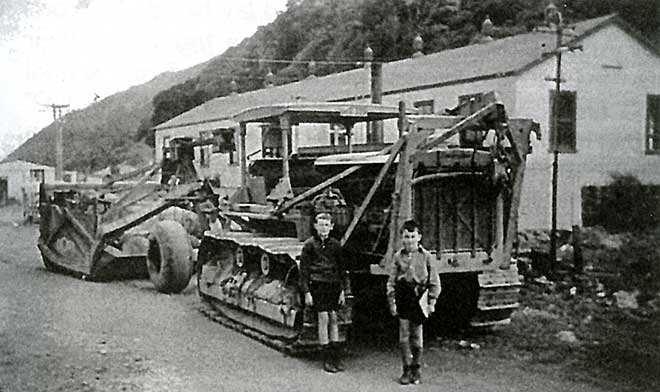
Angus Langbein (right) recalls his life at the Aniseed (now Rākautara) construction camp, the base for completing the railway from Wharanui to Kaikōura. He was 6–10 years old at that time and his father was engineer-in-charge. By today’s standards, living conditions were spartan – including for his family – but this did not dampen the spirits of Angus and his mates.
What\'s you story?
Contributed by Angus Langbein
Even by the standards of the 1930s Aniseed was very isolated. The camp was temporary, existing only for so long as needed as a base for railway construction. The highway from Blenheim to Kaikōura was virtually all unsealed and some creeks had to be forded. At one ford a local farmer used to offer a service – ‘half a crown to pull you through, five bob if I have to come and get you’ (in 2011 terms $12.50 and $25).
Few people owned cars though, and travel to Blenheim or Kaikōura was usually by bright red Newmans Brothers service cars. Those cars also, without stopping, threw newspapers to each gateway with a Press or Star-Sun sign. Like all lads, I marvelled at the accuracy of the delivery, particularly when the papers were thrown by the driver out his window and over the car roof, to a gateway on the left side of the road.
A store offered a range of goods including sweets – yes, a boy would remember that! But it certainly did not stock meat, which was bought from the butcher’s van which came out from Kaikōura. We kids tried to bludge saveloys from the driver, which we then ate without further cooking.
The steep hinterland ran generally right to the tide line. Areas of flat land were few and far between, to the extent that the camp had to be spread over three distinct locations, with the school separate again.
The ‘staff’ camp, plus the workshops, office, YMCA and dental clinic, were situated where the Aniseed Creek reached the sea. The YMCA hall was used for dances, badminton, church services, some school activities and movies. There was only one projector and a pianist played while film reels were rewound and changed over.
Electricity was only used for lighting – my father had to disconnect one household when it was found to be using an electric iron.
In southerly storms the seas drove onshore so strongly that waves invaded some backyards in the more seaward row of houses. During one storm the postmistress was blown over while trying to walk along the road and in another the single staff cookhouse lost its roof.
It was a marvellous experience to spend part of my boyhood on the Kaikōura coast. Once a friend and I were so engrossed fishing on a school day morning that we lost track of time – our apprehension as we hurried to school was well justified!
There were sea and reefs at the front door full of fish and crayfish, bush at the back door with limitless scope for tree huts, bird-nesting, supplejack climbing, a creek to swim in and canoe on, and much else. A wonderful life indeed for a boy.
Using this item
Private collection
This item has been provided for private study purposes (such as school projects, family and local history research) and any published reproduction (print or electronic) may infringe copyright law. It is the responsibility of the user of any material to obtain clearance from the copyright holder.











Add new comment